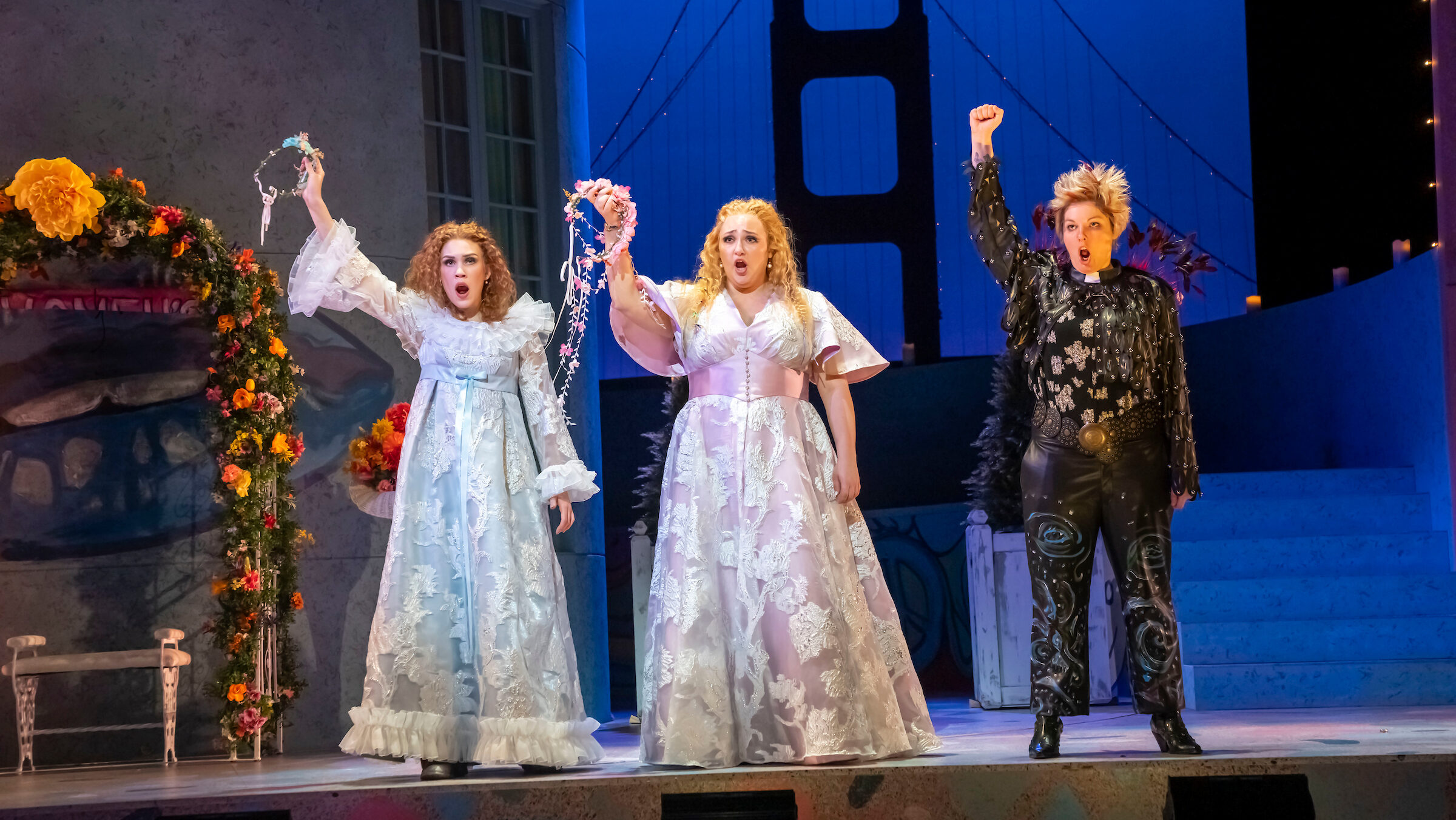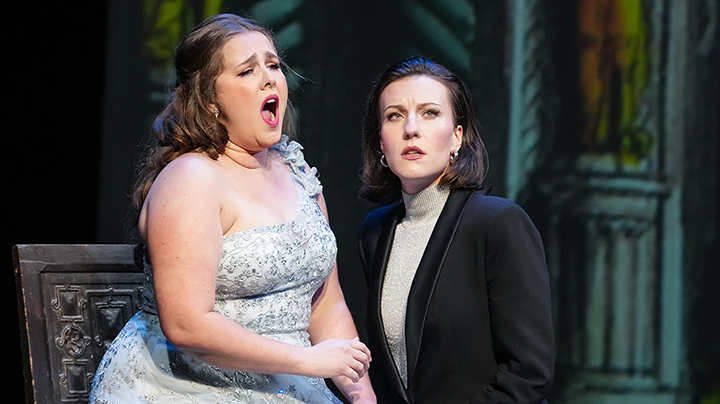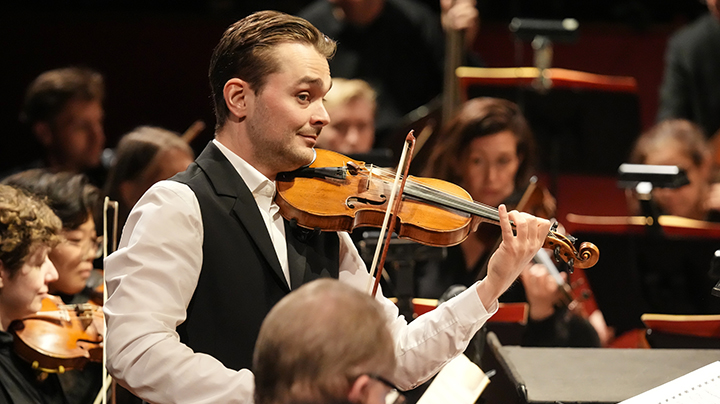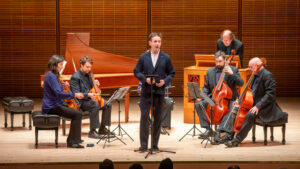
I Capuleti e i Montecchi, Vincenzo Bellini’s setting of the Romeo and Juliet story, was an immediate success in Venice in 1830 ending a run of bad luck for the Sicilian composer. It was but one of several successful Italian versions of the tragic love story – two of which by Zingarelli and Vaccai were still being performed at the time Bellini’s version premiered – hence the different title for Bellini’s take. None of these operas were based on Shakespeare’s play, but a tragedy by Luigi Scevola derived from the Luigi da Porto and Matteo Bandello novellas.
The Zingarelli and Vaccai Giulietta e Romeo operas share DNA with Bellini’s version. Zingarelli was Bellini’s composition professor at the Naples Conservatory. Felice Romani wrote the libretto for the Vaccai Giulietta e Romeo and revised, condensed and recycled it for Bellini, who was composing in a hurry. The final act of Vaccai’s opera was often substituted for Bellini’s – notably by Maria Malibran – a practice which infuriated Bellini. Bellini’s opera was an immediate success and toured the world (Wagner conducted it in Riga in 1835) but by the twentieth century, it had disappeared from operatic stages.
The first performance in the 20th century allegedly was a RAI concert in 1957-58 conducted by Lorin Maazel with Fiorenza Cossotto and Antonietta Pastori (released on CD on the Myto label). A year later it came to New York via Allen Sven Oxenburg and the American Opera Society with Giulietta Simionato and Laurel Hurley. Simionato returned to the AOS for a repeat in 1964 with parterre fave Mary Costa as Giulietta. The Metropolitan Opera has never performed it despite the presence of Anna Netrebko and Joyce DiDonato (and sporadically Elina Garanca) on their roster (there were rumors of a projected production 20 years ago or more). I think Netrebko moved on to other repertory and the Met never had a commitment to revive bel canto, so it went by the wayside.
I saw Capuleti at the Lyric Opera of Chicago in 1985 with Cecilia Gasdia and Tatiana Troyanos in a lovely production. I realize now with shock that that was nearly 40 years ago… In 2001, New York City Opera premiered a new production with Sarah Connolly and Mary Dunleavy who did justice to the beauties of the score. Opera Orchestra of New York performed it in concert three times. I was too young for Tatiana Troyanos and Ashley Putnam in 1979 but vividly remember a debuting Jennifer Larmore with an incandescent Mariella Devia in 1994. Then in 1999, Vesselina Kasarova and Annick Massis performed it for OONY at Carnegie Hall.
OONY founder Eve Queler (age 93) was in attendance last night at Teatro Nuovo’s semi-staged concert presentation of I Capuleti e i Montecchi and was greeted with fondness by many opera and voice fanatics in the audience who relished her presentations in years past. The Glimmerglass Festival presented it in 2008 during a “Shakespeare” themed season (Capuleti is a lot of things but it ain’t Shakespeare) with Sandra Piques Eddy/Emily Righter and the exquisite Sarah Coburn. Will Crutchfield led the opera himself at Bel Canto at Caramoor back in July 2012 with Kate Aldrich and Eglise Gutiérrez neither of whom were in their best form. (History lecture over, kiddies, you know I can’t help myself given the space…)
Teatro Nuovo functions differently from Bel Canto at Caramoor, focusing on young singers at the very beginning of their careers with an emphasis on training them in the foundations of bel canto. So there are no stars, but a lot of style, erudition and good musicianship. Critical editions of the scores are consulted as well as contemporary vocal treatises. The orchestra for their concerts uses historical instruments and is at audience level with a Primo Violino e Capo d’Orchestra as conductor and a Maestro al Cembalo at the fortepiano accompanying recitatives (sometimes doubled by cello). Last night Jakob Lehmann was the Primo Violino with Mo. Crutchfield presiding at the fortepiano.
With the memories of Troyanos, Gasdia, Larmore, Devia and Kasarova replaying in my mind, it was hard to accept these very sensitive, beautifully prepared but less than vocally stellar young artists in this very voice driven opera. But they made up in commitment, style, and informed phrasing for what they lacked in vocal glamor – the whole was greater than the sum of the parts.
The best performance all around came from rising young mezzo-soprano Stephanie Doche as Romeo – and she started out unpromisingly. (She was a replacement for the originally announced Simone McIntosh) There is a resinous lean timbre rather reminiscent of Kate Lindsey’s but her tone sounded strangely bottled up with some hollow tones in the bottom and upper registers. By the second act, Doche’s voice seemed warmed up and more confidently deployed and she even managed a trill in the final death scene. Doche was intensely engaged with the text and phrased with dramatic intention, bel canto style and elegant musicianship. The Rochester, New York native seems to be a talent to watch.
Coloratura soprano Alina Tamborini has appeared with Teatro Nuovo before in lesser roles like Berta in Il Barbiere di Siviglia and Isoletta in La Straniera. She seemed sweet but a little green in those parts. As Giulietta she left a mixed impression with some serious caveats. The phrasing was lovely as long as the voice remained steady. She was decorating the line ambitiously but with some sense of style. There was emotional engagement and she was coached to sing off the text with specific meaning. She was intense in her expression of grief and despair.
The voice itself is high placed but shallowly supported – there is a fluttery vibrato that pushes high notes sharp and disrupts legato singing. Middle tones can fail to phonate fully. She does, thanks to the fast vibrato, have a very easy trill which she uses lavishly. But the lack of firm breath support and the quivery, overbright timbre did not let one settle into the vocal lines which sounded jittery and uneasy. Crutchfield included the short dramatic arioso passage –– “Morir dovessi ancora” –– equivalent to Juliet’s “potion” speech in Shakespeare, that Bellini added to Giulietta’s Act II duet with Lorenzo in the 1831 La Scala production – a restoration he also made at Caramoor. It gives Giulietta more spirit and less passive droopiness which seems to be her default mode.
Amanda Woodbury, who appeared with Teatro Nuovo as Amenaide in their Tancredi in 2018 would have been a better choice though she has been dipping her toe into more dramatic coloratura roles. In fact, either of the 2018 Tancredis – Tamara Mumford and Aleks Romano – would have excelled as Romeo. But Mumford has been less active this season and Romano, sadly, has left performing to work in the business sector (like Laura Vlasek Nolen before her, another fine mezzo). I found Romano a major talent.
The rest of the cast was merely functional at best. Robert Kleinertz, our tenor Tebaldo, has mainly sung opera at the Boston Conservatory where he may still be a student. He is a work in progress with a voice that can ring out brightly or bleat like a sheep. This young man seemed stiff both physically and vocally – he needs more time in the oven before he is served as a main course.
Kyle Oliver as Lorenzo sounded like a lightweight baritone Masetto needing more gravitas while Michael Leyte-Vidal as Capellio has good, rich vocal material that lacked rhythmic shape, detail, and focus in his delivery. Neither role is important enough to seriously derail the proceedings which focuses squarely on the young lovers pushing everyone else to the side.
The semi-staging was deliberately simple with merely a chair or bier for Giulietta to lie upon. Costumes were modern concert black suits for the men and evening gowns for the ladies, slacks for Romeo. Rear projections on an upstage scrim revealed evocative watercolors of primo ottocento set designs after Alessandro Sanquirico with English titles projected at the top. Stage director (and erstwhile buffo baritone) Marco Nisticò wasn’t ambitious with the (reduced) chorus who mainly lined up in rows on either side of the principals but provided good personenregie for the intimate scenes with the lovers. It showed you how little you really need to stage an opera when the singers are committed and the music is dramatic and moving – I felt I got the whole story from the interactions of the singers, the atmospheric projected backgrounds and the music itself which engages directly with the heart.
The orchestral playing was generally very good aside from some pitchy-poo with the valveless horns. The solo clarinet solo in the second act, by Maryse Legault, drew applause. The strings have a less brilliant timbre and the woodwinds are mellower giving a darker color to the orchestral sonority. Lehmann favored forward moving, lively tempos taking time to luxuriate in lyrical passages.
A pre-performance concert showcased the Teatro Nuovo young artists (who double as the opera chorus) singing arias and scenes from the Vaccai and Zingarelli operas with a duet by Stephen Foster “Wilt Thou Be Gone, Love?” from Shakepeare’s text accompanied by Timothy Cheung on the piano, Romeo mourning over Juliet’s tomb seems to have been the scene where composers – several of whose Romeo and Juliet adaptations were recently featured on parterre’s Chris’s Cache podcast — were particularly inspired.
Franco Fagioli sings the Zingarelli (composed by the original Romeo, Girolamo Crescentini):
https://
Here is Vaccai with Marilyn Horne doing the “Malibran” version:
https://
Georges Thill in the Gounod opera:
https://
From the Zandonai opera with Miguel Fleta:
Jan de Gaetani sings the Foster duet with Leslie Guinn, baritone:
Given that New York City hasn’t heard Bellini’s beautiful opera in over twenty years, it was high time for it to come back, though Capuleti is now no stranger to the world’s stages. The opera itself was the star which isn’t a bad thing but bel canto needs just that – “beautiful singing.” We need stars in our bel canto heaven. They are out there and, hopefully, Crutchfield will find them and make them glow at their brightest. They have the means.
Photos: Steven Pisano




























Comments